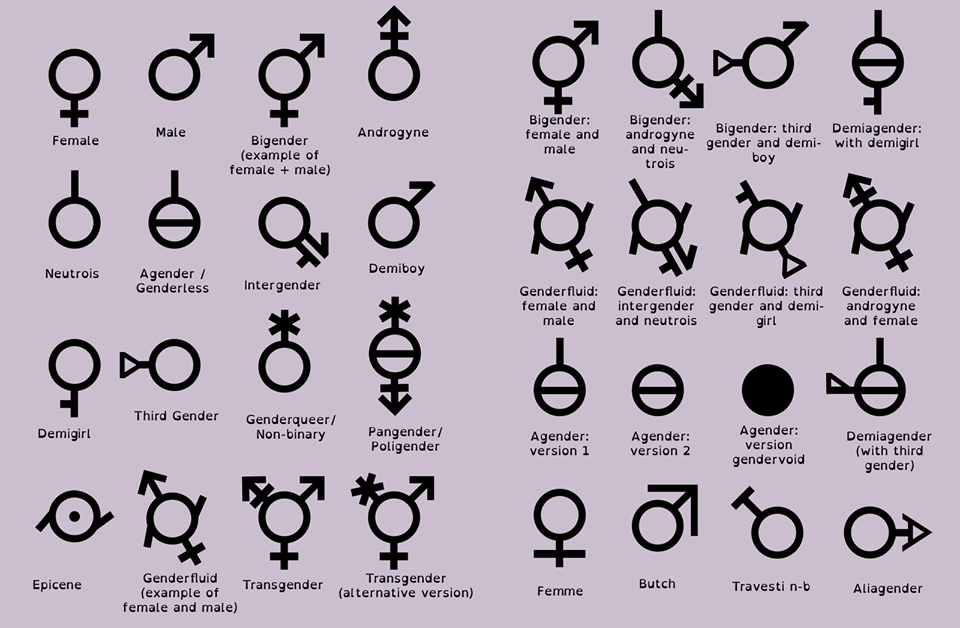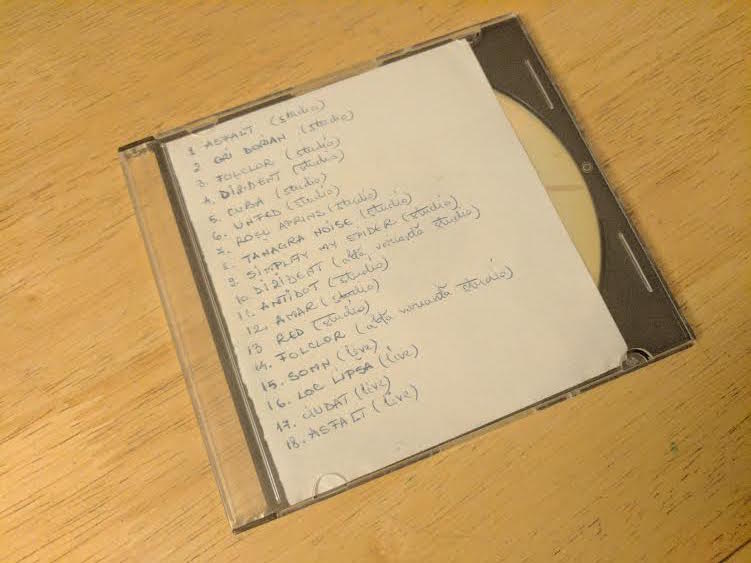Ieri, in timp ce stalk-uiam pagina de Facebook a lui Esther Perel am dat peste asta:

Pot sa zic ca nu inteleg ce se petrece cu toata simbolistica si terminologia asta?
Cand am vazut-o mi-au venit in minte sutele de delimitari conceptuale si modele interpretativ-explicative din cartile galbene ale lui Zlate pe care a trebuit sa le invat in facultate.
Sex… Gen… Identitate… Orientare…
Ma intreb in ce masura vine sa revolutioneze acest model teoretic de reprezentare a omului ceea ce exista deja. Unde este added-value-ul care il face inovator si necesar in cercetarea omului?
Cu ochelarii mei actuali, care pot fi unii de cal, nu neg, eu vad doar un snop de etichete. Vrem libertate de exprimare de orice fel, dar in acelasi timp simtim nevoia sa etichetam fiecare comportament uman. Avem nevoie de casute mici in care sa ne bagam unii pe altii ca sa nu ne discriminam.
Pentru ca daca stiu ca esti genderfluid: third gender and demigirl, o sa imi fie mai usor sa te accept pentru ca te inteleg. Oare? De cand am devenit atat de pretentiosi in definirea operationala sexualitatii umane si identitatii de gen?
Einstein, dragul de el, avea o vorba: If you can’t explain it to a six year old, you don’t understand it yourself.
De la Kinsey incoace stim ca sexualitatea e mai mult sau mai putin fluida, iar de cand lumea si pamantul stim ca nici un om nu seamana cu altul, chiar si atunci cand seamana.
Ceea ce inteleg e ca dihotomia de gen feminin – masculin poate fi apasatoare cand subiectului ii e greu sa bifeze full-heartedly una dintre cele doua casute. Dar de aici, la a ne duce pana in panzele albe cu combinatii de n luate cate k de comportamente, valori, idei de viata pe care ni le scriem pe frunte auto-proclamandu-ne ceva cu nume complicat de retinut, e cale foarte lunga.
Simplitate, inainte de toate!
Dar nu ma intelegeti gresit! Nu ma refer la simplitatea gandirii, la bagatelizarea unor subiecte care pana nu demult erau varate sub covorul tabuurilor sociale.
Ce isi doreste aceasta noua paradigma de reprezentare a omului? Daca isi doreste sa fie inteleasa de oameni… se prezinta cam complicat! Daca vrea sa fie acceptata ca idee viabila… suna cam teoretico-SF (in my opinion your Honour!).
Demersul asta seamana foarte mult cu ce se intampla de ceva vreme in manualele de diagnostic psihiatric.
Din dorinta de a defini mai cu zel niste concepte diagnostice, se recurge la introducerea in simptomatologie a unor comportamente care tin de normalitate, cu explicatia ca dom’le doar daca se manifeste impreuna 6 din 10 atunci avem o problema.
In ograda asta, tot dintr-un zel excesiv (zic eu), ajung sa imi pun problema: Bai daca sunt cisgender, asta e de bine sau de rau?
Si acum pentru ca nu raman niciodata la stadiul de ‘nu inteleg’ mai jos aveti niste incercari ale mele de intelegere a simbolisticii redate mai sus:
FEMALE = the sex of an organism, or a part of an organism, that produces non-mobile ova (egg cells). Most female mammals, including female humans, have two X chromosomes.
MALE = male organism is the physiological sex that produces sperm. Each spermatozoon can fuse with a larger female gamete, or ovum, in the process of fertilization.
ANDROGYNE = a person who does not fit neatly into the typical masculine and feminine gender roles of their society.
NEUTROIS = There is no one definition of Neutrois, since each person that self-identifies as such experiences their gender differently. The most common ones are:
Neutral-gender
Null-gender
Neither male nor female
Genderless
Agender
AGENDER / GENDERLESS (also called genderfree, non-gendered, or ungendered) = someone who identifies as having no gender or being without a gender identity.
INTERGENDER = a variation in sex characteristics including chromosomes and or genitals that do not allow an individual to be directly identified as male or female.
DEMIBOY (also called a demiboy, demiman or demimale person) = a gender identity describing someone who partially, but not wholly, identifies as a man, boy or otherwise masculine, whatever their assigned gender at birth. They may or may not identify as another gender in addition to feeling partially a boy or man.
DEMIGIRL (also called a demiwoman or a demifemale person) = a gender identity describing someone who partially, but not wholly, identifies as a woman, girl or otherwise feminine, whatever their assigned gender at birth. They may or may not identify as another gender in addition to feeling partially a girl or woman.
THIRD GENDER (or third sex) = a concept in which individuals are categorised, either by themselves or by society, as neither man nor woman. It also describes a social category present in those societies that recognise three or more genders.
GENDERQUEER / NON-BINARY = a catch-all category for gender identities that are not exclusively masculine or feminine — identities which are thus outside of the gender binary and cisnormativity.
PANGENDER / POLIGENDER = a non-binary gender experience which refers to a wide multiplicity of genders that can (or not) stretch to the infinite (meaning that this experience can go beyond the current knowledge of genders), always within the person’s own culture and life experience.
EPICENE = having characteristics of both sexes or no characteristics of either sex; of indeterminate sex.
GENDERFLUID = a gender identity which refers to a gender which varies over time. A gender fluid person may at any time identify as male, female, neutrois, or any other non-binary identity, or some combination of identities. Their gender can also vary at random or vary in response to different circumstances.
GENDERFLUID (MALE AND FEMALE), GENDERFLUID (INTERGENDER AND NEUTROIS), GENDERFLUID (THIRD GENDER AND DEMIGIRL) & GENDERFLUID (ANDROGYNE AND FEMALE)
TRANSGENDER = Transgender people are people who have a gender identity or gender expression that differs from their assigned sex.
BIGENDER (MALE AND FEMALE), BIGENDER (ANDROGYNE AND NEUTROIS), BIGENDER (THIRD GENDER AND DEMIBOY) = gender identities which can be literally translated as ‘two genders’ or ‘double gender’. Bigender people experience exactly two gender identities, either simultaneously or varying between the two. These two gender identities could be male and female, but could also include non-binary identities.
DEMIAGENDER: WITH DEMIGIRL = one who identifies partially as agender, and partially as demigirl.
GENDERVOID = Gender 404
DEMIAGENDER (WITH THIRD GENDER) = a gender identity that involves feeling a partial, but not a full, connection to a particular gender identity. Demigender people often identify as non-binary.
BUTCH & FEMME
Butch and femme are terms used in the lesbian and gay subculture to ascribe or acknowledge a masculine (butch) or feminine (femme) identity with its associated traits, behaviors, styles, self-perception and so on. The terms were founded in lesbian communities in the twentieth century. This concept has been called a “way to organise sexual relationships and gender and sexual identity”. Butch-femme culture is not the sole form of a lesbian dyadic system, as there are many women in butch–butch and femme–femme relationships.
TRAVESTI N-B = a travesti who has a nonbinary identity, such as genderfluid, bigender, etc.
ALIAGENDER = A gender separate from man or woman, that is not androgynous, or neutral, but instead a strong, specific gendered feeling other than man or woman.
Acu’-i acu’: io cine/ce sunt?


